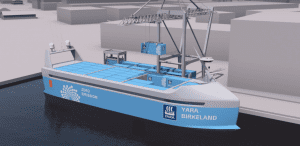The argument for making synthetic fuel from CO2 using renewable electricity in an increasingly electrified world is by now a familiar one.

Photo of the earth taken on an instant film. In the background, there is a fossil fuel powered vehicle, while in the foreground there is an electric vehicle. There are two versions of the future, never say never. Graphical concept and artwork, courtesy of Chenxi Qian.
It hinges on the unlikely scenario that lithium ion batteries will never power the massive fleet of large-volume transportation cargo ships and container trucks, carrying goods around the world. This is simply because of their much lower energy density, currently a factor of about 16x by volume and around 48x by weight, compared to hydrocarbon fuel.
Yet, to be fair, one gets more energy for traction out of a lithium ion battery per energy stored with drivetrain efficiencies of 75% for an all-electric system, compared to about 50% for the ship’s internal combustion engine and 35% for the truck’s engine. Hence, with this correction one obtains a factor of 10x (for the ship) and 7.5x (for the truck) larger volume of a lithium ion battery providing the same “traction” as a given volume of hydrocarbon fuel or 32x (for the ship) and 22x (for the truck) higher weight. It is expected that these factors will likely fall with continuing progress in battery technology.
While, this is not so bad for the battery case, the cost/durability, environmental impact and the need to build up more renewable electricity generation remains challenging. Regarding cost, fuel from electricity is also not so easy to achieve and obviously also needs more renewable electricity.
With regards to the “energy density gap” between fuel and battery power, this will translate into a reduction in the amount of cargo that can be carried by electrified ships and trucks.
Then there is the question of cradle to grave greenhouse gas emissions for large-scale deployment of battery technology in planes, ships, cars and trucks, raising the questions of is it really better, what about the cost and don’t forget the other sustainable options, such as liquefied natural gas, synthesized from renewable carbon sources as well as liquid organic hydrogen carriers charged with renewable hydrogen. On these questions, life cycle assessments are crucial for estimating materials, energy and economic flows for electric versus fuel transportation systems, enabling one to weigh different options and make rational decisions.
For practitioners and champions of CO2 sourced synthetic fuels, the mantra is to do as much as possible using renewable electricity, however it makes sense to turn CO2 into synthetic fuels for large volume cargo ship and truck based transportation systems. The reality remains that the heavy fuel oil and diesel fuel used to power cargo ships and container trucks respectively, generate huge amounts of greenhouse gas and there is an urgent need for the world’s transportation industries to be electrified.
Kongsberg, a maritime engineering firm, and Yara International ASA, a large Norwegian chemical company, are taking this adventurous and exciting step towards electrification of an autonomous cargo ship. For this pilot project, Kongsberg is developing the battery system, electric drive and all the components for seaborne transportation and autonomous navigation. The plan is to initially use the vessels to substitute for land transport with the ultimate goal being to replace large vessels.
The first vessel is being financed by Yara and will ship products between its Porsgrunn plant to ports in Brevik and Larvik. This electrified cargo ship will replace the current use of more than 100 diesel trucks, which ship these goods each day, thereby eliminating their associated greenhouse gas, nitrous oxide, dust and noise emissions. By 2019, it is planned to use the electric vessel for longer journeys and by 2020 it is expected to be ready for autonomous operation, [1].

Figure 1. A new all-electric and autonomous zero emission cargo ship planned for operation in 2018, [1].
We have always believed ‘never say never’ when it comes to what seem like impossible feats of science and engineering. With Kongsberg’s advance, we are not so sure, fuel oil powered cargo ships will never be electrified and we would not bet the farm that container trucks and planes would not follow suit in the not too distant future, just as we see it happening before our very eyes with electrified cars.
The Times They Are A-Changin, Bob Dylan, 1964.
Written by Geoffrey A. Ozin1 and Roland Dittmeyer2
1 Materials Chemistry and Nanochemistry Research Group, Solar Fuels Cluster, Center for Inorganic and Polymeric Nanomaterials, Chemistry Department, 80 St. George Street, University of Toronto, Toronto, Ontario, Canada M5S 3H6, EMail: [email protected], Web Sites: www.nanowizardry.info, www.solarfuels.utoronto.ca, www.artnanoinnovations.com
2 Institute for Micro Process Engineering, Karlsruhe Institute of Technology, Hermann-von-Helmholtz Platz 1, 76344 Eggenstein-Leopoldshafen, Germany, Email: [email protected], Web Site: www.imvt.kit.edu
Reference:

















